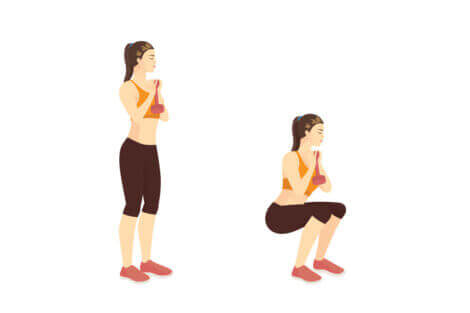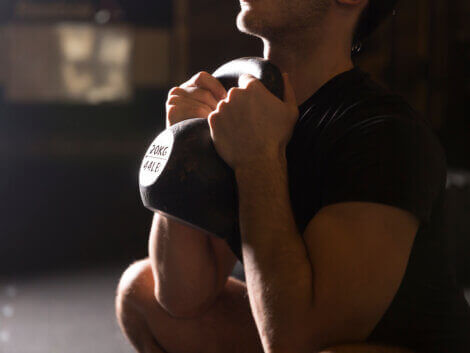The Muscles You'll Work With The Goblet Squat

Legs are one of the most important body parts, which means you should regularly train the leg muscles with discipline and patience. To achieve great results, you can include the goblet squat in your routine. Have you ever tried it?
If you want to know what goblet squats are, what they’re for, and what muscles are involved, just keep reading. Remember that knowledge can improve your training routine.
What are goblet squats?
There are a large number of squat variations. Broadly speaking, this kind of exercise strengthens the leg area, and depending on which variation you choose to do, you’ll be exercising different sets of muscles.
For what it’s worth, the goblet squat is quite conventional with a very important variant: weight. To “create” weight, you may use a dumbbell or a kettlebell, which you should hold with your upper limbs.
This type of squat is one of the most recommended variations, not only to include in a routine to work the core but as a warm-up exercise. Of course, this will depend on your training coach and the weight of the dumbbell you’ll be using.
What muscles does the goblet squat work?
Since the goblet squat focuses on the lower body, it mainly works leg muscles. However, within these, other muscles are also used while performing the squat. The most relevant muscles that the goblet squat works are the glutes, the quadriceps femoris, the adductors, and the hamstrings.

- Glutes: strengthening your glutes with the goblet squat depends on how low you’re able to squat. The farther you squat down, the more you work your glutes.
- Quadriceps femoris: this is the biggest muscle in the body, consisting of four individual muscles, and it’s the main one involved in this type of exercise.
- Adductors and hamstrings: these are the antagonist muscles, helping with both hip flexion and extension.
In addition, there’s a number of upper-body muscles involved in the goblet squat thanks to the dumbbell or kettlebell used to increase the complexity of the exercise.
In this case, the arm muscles perform isometric exercises. This type of effort occurs when muscles resist an external force without moving in any way.
- Delts generate tension due to the use of external weight and contribute resistance to force.
- Biceps brachii: it’s the main arm flexor and one of the largest muscles in the upper body. During the goblet squat, it’s subjected to an isometric effort that allows for optimal training.
Other important muscles involved
The above-mentioned muscles are the main executors of the goblet squat, no matter their function. However, there are other important muscle groups involved in this exercise that make this type of squat a very complete exercise: these are the ones that make up the core, abdominal, lumbar, and dorsal areas. The glutes are also part of this (but we’ve already mentioned them), as well as the gastrocnemius muscle and the foot flexors.

Why you should specifically do the goblet squat
The fact that you get to work many muscles with this exercise is a good enough reason to do it regularly. Apart from that, goblet squats are ideal for improving posture. Working with dumbbells forces the back to remain erect, which is an important position to maintain in order to properly do a squat. It can also be the first step in improving your over-all squat technique and trying more squat variations.
Goblet squats and back problems
The main problem with executing a conventional squat is the technique, which is where goblet squats come in handy. As we mentioned before, this is a good enough reason to do them.
On the other hand, they’re usually appropriate for people with back problems, who suffer from the curvature when performing a conventional squat. Lifting an eight-pound dumbbell with your arms helps to solve this particular issue.
Legs are one of the most important body parts, which means you should regularly train the leg muscles with discipline and patience. To achieve great results, you can include the goblet squat in your routine. Have you ever tried it?
If you want to know what goblet squats are, what they’re for, and what muscles are involved, just keep reading. Remember that knowledge can improve your training routine.
What are goblet squats?
There are a large number of squat variations. Broadly speaking, this kind of exercise strengthens the leg area, and depending on which variation you choose to do, you’ll be exercising different sets of muscles.
For what it’s worth, the goblet squat is quite conventional with a very important variant: weight. To “create” weight, you may use a dumbbell or a kettlebell, which you should hold with your upper limbs.
This type of squat is one of the most recommended variations, not only to include in a routine to work the core but as a warm-up exercise. Of course, this will depend on your training coach and the weight of the dumbbell you’ll be using.
What muscles does the goblet squat work?
Since the goblet squat focuses on the lower body, it mainly works leg muscles. However, within these, other muscles are also used while performing the squat. The most relevant muscles that the goblet squat works are the glutes, the quadriceps femoris, the adductors, and the hamstrings.

- Glutes: strengthening your glutes with the goblet squat depends on how low you’re able to squat. The farther you squat down, the more you work your glutes.
- Quadriceps femoris: this is the biggest muscle in the body, consisting of four individual muscles, and it’s the main one involved in this type of exercise.
- Adductors and hamstrings: these are the antagonist muscles, helping with both hip flexion and extension.
In addition, there’s a number of upper-body muscles involved in the goblet squat thanks to the dumbbell or kettlebell used to increase the complexity of the exercise.
In this case, the arm muscles perform isometric exercises. This type of effort occurs when muscles resist an external force without moving in any way.
- Delts generate tension due to the use of external weight and contribute resistance to force.
- Biceps brachii: it’s the main arm flexor and one of the largest muscles in the upper body. During the goblet squat, it’s subjected to an isometric effort that allows for optimal training.
Other important muscles involved
The above-mentioned muscles are the main executors of the goblet squat, no matter their function. However, there are other important muscle groups involved in this exercise that make this type of squat a very complete exercise: these are the ones that make up the core, abdominal, lumbar, and dorsal areas. The glutes are also part of this (but we’ve already mentioned them), as well as the gastrocnemius muscle and the foot flexors.

Why you should specifically do the goblet squat
The fact that you get to work many muscles with this exercise is a good enough reason to do it regularly. Apart from that, goblet squats are ideal for improving posture. Working with dumbbells forces the back to remain erect, which is an important position to maintain in order to properly do a squat. It can also be the first step in improving your over-all squat technique and trying more squat variations.
Goblet squats and back problems
The main problem with executing a conventional squat is the technique, which is where goblet squats come in handy. As we mentioned before, this is a good enough reason to do them.
On the other hand, they’re usually appropriate for people with back problems, who suffer from the curvature when performing a conventional squat. Lifting an eight-pound dumbbell with your arms helps to solve this particular issue.
All cited sources were thoroughly reviewed by our team to ensure their quality, reliability, currency, and validity. The bibliography of this article was considered reliable and of academic or scientific accuracy.
- Chijani, N. (2013). Análisis Biomecánico De Las Sentadillas. G-SE Sobre Entrenamiento.
- Cronin, J. Keogh, J. Presswood, L. Whatman, C. (2008). Glúteo medio: Anatomía aplicada, disfunción, valoración y fortalecimiento progresivo. Strength and Conditioning Journal.
- Staugaard-Jones, J. A. (2014). Anatomía del ejercicio y el movimiento. Anatomía Del Ejercicio y Movimiento.
This text is provided for informational purposes only and does not replace consultation with a professional. If in doubt, consult your specialist.








